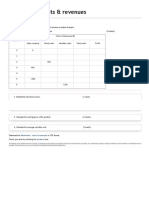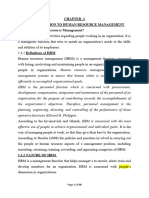0 ratings0% found this document useful (0 votes)
72 viewsBusiness Management IB Unit 1
Business Management IB Unit 1
Uploaded by
VALENTINA MÓNACOThis document outlines the key concepts covered in Unit 1 of an IB Business Management course. It includes definitions of important terms and an overview of topics like business organization types, objectives and planning. Specifically, it covers:
1) Definitions of business, consumer and capital goods, and examples of primary, secondary and tertiary sector businesses. It also differentiates between entrepreneurs and intrapreneurs.
2) Differences between public and private sectors, and between sole traders and private limited companies. It also discusses public-private partnerships and for-profit and non-profit social enterprises.
3) The importance of mission and vision statements having SMART objectives, and the definition of corporate social responsibility. It also compares SWOT
Copyright:
© All Rights Reserved
Available Formats
Download as PDF, TXT or read online from Scribd
Business Management IB Unit 1
Business Management IB Unit 1
Uploaded by
VALENTINA MÓNACO0 ratings0% found this document useful (0 votes)
72 views2 pagesThis document outlines the key concepts covered in Unit 1 of an IB Business Management course. It includes definitions of important terms and an overview of topics like business organization types, objectives and planning. Specifically, it covers:
1) Definitions of business, consumer and capital goods, and examples of primary, secondary and tertiary sector businesses. It also differentiates between entrepreneurs and intrapreneurs.
2) Differences between public and private sectors, and between sole traders and private limited companies. It also discusses public-private partnerships and for-profit and non-profit social enterprises.
3) The importance of mission and vision statements having SMART objectives, and the definition of corporate social responsibility. It also compares SWOT
Original Description:
BM IB practice
Copyright
© © All Rights Reserved
Available Formats
PDF, TXT or read online from Scribd
Share this document
Did you find this document useful?
Is this content inappropriate?
This document outlines the key concepts covered in Unit 1 of an IB Business Management course. It includes definitions of important terms and an overview of topics like business organization types, objectives and planning. Specifically, it covers:
1) Definitions of business, consumer and capital goods, and examples of primary, secondary and tertiary sector businesses. It also differentiates between entrepreneurs and intrapreneurs.
2) Differences between public and private sectors, and between sole traders and private limited companies. It also discusses public-private partnerships and for-profit and non-profit social enterprises.
3) The importance of mission and vision statements having SMART objectives, and the definition of corporate social responsibility. It also compares SWOT
Copyright:
© All Rights Reserved
Available Formats
Download as PDF, TXT or read online from Scribd
Download as pdf or txt
0 ratings0% found this document useful (0 votes)
72 views2 pagesBusiness Management IB Unit 1
Business Management IB Unit 1
Uploaded by
VALENTINA MÓNACOThis document outlines the key concepts covered in Unit 1 of an IB Business Management course. It includes definitions of important terms and an overview of topics like business organization types, objectives and planning. Specifically, it covers:
1) Definitions of business, consumer and capital goods, and examples of primary, secondary and tertiary sector businesses. It also differentiates between entrepreneurs and intrapreneurs.
2) Differences between public and private sectors, and between sole traders and private limited companies. It also discusses public-private partnerships and for-profit and non-profit social enterprises.
3) The importance of mission and vision statements having SMART objectives, and the definition of corporate social responsibility. It also compares SWOT
Copyright:
© All Rights Reserved
Available Formats
Download as PDF, TXT or read online from Scribd
Download as pdf or txt
You are on page 1of 2
IB Business Management
Unit I: Business Organisation and Enviroment
Card 1: Introduction to Business Management
Define:
a. What is a Business.
b. Consumer goods.
c. Capital goods.
State TWO examples of primary sector businesses, TWO os secondary sector and TWO
of tertiary sector businesses and explain why.
Differentiate between entrepreneur and intrapreneur
Explain TWO steps in the process of starting up a business and TWO problems
commonly experienced by new business start-ups.
Card 2: Types of Organisation
Outline de differences between public and private sector
State and explain THREE differences between a soletrader and a private limited
Company.
Explain what is a public-private partnership
Evaluate for-profit social enterprises and non-profit social enterprises.
Card 3: Organisational Objetives
Define mission statement and visión statement.
Describe why obejetives should be SMART.
Explain what is Corporate Social Responsability.
Compare and contrast the tools of SWOT ANALYSIS and ANSOFF´S MATRIX.
Card 4: Stakeholders
Define stakeholder and give three examples.
Do activity 1.4.2 on page 65
What do you understand by the term “conflicts between stakeholder´s interests”?
Card 5: External Enviroment
Define economic growth, recession and Exchange rate.
Describe Steeple analysis.
Explain ONE example of how enviromental considerations have affected the strategy of
a business.
Why should a business consider the political situation in a country that it plans to
expand into.
Explain ONE problema that a business could experience if it did not accout for different
ethical standars in the countries it operates in.
Card 6: Growth and Evolution
Define Economies of scale and diseconomies of scale.
Select and describe TWO economies of scale and only ONE diseconomies of scale.
Explain the differences of Internal and external growth.
Taking into consideration the chart on page 96 “type of integrations” select TWO of
them and compare its benefits and limitations.
Define and state the main characteristics of a joint ventures, strategic alliances and
franchising.
Card 7: Organisational Planning Tools
Define organisational plannig
Describe what is a project manager.
Do activity 1.7.2 exercise 1 on page 111.
Explain what is a Lewis forcé field analysis and outline ONE advantage and ONE
disadvantage.
Explain TWO possible benefits and TWO limitations of using a Gantt chart.
You might also like
- HL IA Rubric New Assessment 2024 BDDocument1 pageHL IA Rubric New Assessment 2024 BDJimmy RoblesNo ratings yet
- Business Management Paper 1 SL MarkschemeDocument11 pagesBusiness Management Paper 1 SL MarkschemeZaid AbbadiNo ratings yet
- Axis ASAP FlowDocument13 pagesAxis ASAP FlowArbaz KhanNo ratings yet
- Business Management Case Study: Ducal Aspirateurs: Instructions To CandidatesDocument5 pagesBusiness Management Case Study: Ducal Aspirateurs: Instructions To CandidatesJuan Antonio Limo DulantoNo ratings yet
- Pizer Practice QuestionDocument2 pagesPizer Practice QuestionSmily IshaNo ratings yet
- Mukt Tesco PLC - EditedDocument18 pagesMukt Tesco PLC - EditedExpert 123No ratings yet
- HL Business Management 12 Exam 4Document6 pagesHL Business Management 12 Exam 4Micah M100% (1)
- Gec103 Week1 Introduction To GlobalizationDocument12 pagesGec103 Week1 Introduction To GlobalizationAngel Joy CalisayNo ratings yet
- An Empirical Study Understanding The Impact of Digital Advertisement On Real Estate PurchasingDocument72 pagesAn Empirical Study Understanding The Impact of Digital Advertisement On Real Estate PurchasingRohit Venkat0% (2)
- Business Management Paper 1 HL MarkschemeDocument11 pagesBusiness Management Paper 1 HL MarkschemeInes Garcia FNo ratings yet
- Business Management Paper 1 HL MarkschemeDocument13 pagesBusiness Management Paper 1 HL MarkschemeRoad NanjingNo ratings yet
- IB Business Management New Syllabus 2022Document13 pagesIB Business Management New Syllabus 2022Jason NamNo ratings yet
- IB Business Management IADocument36 pagesIB Business Management IAbandinahrohanNo ratings yet
- IB Business and Management Internal AsseDocument18 pagesIB Business and Management Internal AssealvaradoajuanfranciscoNo ratings yet
- Key Terms BM Paper 1 May 2023Document8 pagesKey Terms BM Paper 1 May 2023Neha MathewNo ratings yet
- Skandvig Terra PLC - Google Docs BM Tools For May 2023 Case StudyDocument78 pagesSkandvig Terra PLC - Google Docs BM Tools For May 2023 Case Studysamay bajajNo ratings yet
- (2023) Case Study Prep Step by StepDocument9 pages(2023) Case Study Prep Step by StepMathieu BoulayNo ratings yet
- Ib Business Management 2019 Online SyllabusDocument4 pagesIb Business Management 2019 Online Syllabusapi-451276617No ratings yet
- 003251-3.1 Sources of FinanceDocument53 pages003251-3.1 Sources of FinanceMirellaNo ratings yet
- Extended Essay BM IBDocument51 pagesExtended Essay BM IBAnant JainNo ratings yet
- BM Extended Essay StructureDocument7 pagesBM Extended Essay Structurepriyanka100% (1)
- May 24 Art PcupDocument3 pagesMay 24 Art Pcupaanyadhingra94No ratings yet
- BM, IA LayoutDocument5 pagesBM, IA Layoutkapil chandwani100% (1)
- Grade 9Br Business Studies Chapter 6:motivating EmployeesDocument2 pagesGrade 9Br Business Studies Chapter 6:motivating EmployeesHamza HashimNo ratings yet
- Utopia SWOT Analysis: Ib Business Management - Pre-Released Case Study May 2017: Swot AnalysisDocument2 pagesUtopia SWOT Analysis: Ib Business Management - Pre-Released Case Study May 2017: Swot AnalysisDilip Pandurang Pattil100% (1)
- 1-Dec-20 IB Business Management Worksheet - Costs RevenuesDocument2 pages1-Dec-20 IB Business Management Worksheet - Costs RevenuesVikhyat Agarwal100% (2)
- Grade 9Br Business Studies Chapter 9: Internal and External CommunicationDocument3 pagesGrade 9Br Business Studies Chapter 9: Internal and External CommunicationHamza HashimNo ratings yet
- Extended Essay in Business ManagementDocument22 pagesExtended Essay in Business ManagementRonitt AgarrwalNo ratings yet
- Class Day Test BSC Finance Year 2Document5 pagesClass Day Test BSC Finance Year 2Revatee HurilNo ratings yet
- Test AEKDocument30 pagesTest AEKSourav Mondal50% (2)
- CSP M22 Peacewick UniversityDocument162 pagesCSP M22 Peacewick UniversityMohammad Hamad Hammadi100% (1)
- Cambridge Assessment International Education: Business 9609/13 May/June 2019Document12 pagesCambridge Assessment International Education: Business 9609/13 May/June 2019AbdulBasitBilalSheikhNo ratings yet
- Tesla Steeple: Social Factors Economic FactorsDocument1 pageTesla Steeple: Social Factors Economic FactorsNadeem KaradshehNo ratings yet
- Finance Revision PackDocument31 pagesFinance Revision PackMohammad Hamdan67% (3)
- EE Sample Business HLDocument25 pagesEE Sample Business HLRohan Raju100% (2)
- Culture Change at British AirwaysDocument2 pagesCulture Change at British AirwaysumitiiitNo ratings yet
- Ib Business Management - Command Terms PDFDocument5 pagesIb Business Management - Command Terms PDFKaren Dariana Cabrera DazaNo ratings yet
- Ia-Checklist - 2024Document6 pagesIa-Checklist - 2024Sarina NathaniNo ratings yet
- Paper 2 0 MDocument20 pagesPaper 2 0 MCESAR PILA (XINAEPX)No ratings yet
- IB Business & Management Internal Assessment HL Guide Book: and Summer AssignmentDocument18 pagesIB Business & Management Internal Assessment HL Guide Book: and Summer AssignmentShivani AggarwalNo ratings yet
- BM Worksheet 3Document2 pagesBM Worksheet 3Elizabeth CarterNo ratings yet
- Business KeywordsDocument18 pagesBusiness KeywordsJerusha ENo ratings yet
- Labour Turnover WorksheetDocument9 pagesLabour Turnover Worksheetapi-353215795No ratings yet
- AS AD Worksheet: Part I: Aggregate Demand QuestionsDocument5 pagesAS AD Worksheet: Part I: Aggregate Demand QuestionsKinNo ratings yet
- Unit 1 - IB Business ManagementDocument41 pagesUnit 1 - IB Business ManagementKavita AntonyNo ratings yet
- IB International TradeDocument41 pagesIB International TradeANTHONY AKINYOSOYENo ratings yet
- Exam Paper MarkschemesDocument21 pagesExam Paper MarkschemesDivyaNo ratings yet
- 3 3a Activity Costs and RevenuesDocument3 pages3 3a Activity Costs and RevenuesOmar BokhowaNo ratings yet
- Planning - Starbucks To Refer ToDocument4 pagesPlanning - Starbucks To Refer ToNteboNo ratings yet
- Ib Business Toolkit SummaryDocument4 pagesIb Business Toolkit Summaryemily khievNo ratings yet
- Chapter 2.4 MotivationDocument81 pagesChapter 2.4 Motivationirham QiNo ratings yet
- IB Command Terms - Categorized by Skill LevelDocument6 pagesIB Command Terms - Categorized by Skill LevelpicboyNo ratings yet
- IB Economics Teacing NotesDocument36 pagesIB Economics Teacing NotesVrinda Tayade100% (1)
- Ib Ib Business and Management Case Study 2015 Ladya - Swot AnalysisDocument5 pagesIb Ib Business and Management Case Study 2015 Ladya - Swot AnalysisAnonymous ANo ratings yet
- IB - Econ - New - SyllabusDocument37 pagesIB - Econ - New - SyllabusousoulegrandNo ratings yet
- IB BusinessDocument15 pagesIB BusinessCROSA FELIPENo ratings yet
- Change Management in Apple Inc: Presented By, Praveen Kumar Lagudu 1226309109 LSCMDocument14 pagesChange Management in Apple Inc: Presented By, Praveen Kumar Lagudu 1226309109 LSCMjshfgshjfgNo ratings yet
- HL Business Management Course Outline - FinalDocument14 pagesHL Business Management Course Outline - FinalAnthony QuanNo ratings yet
- IB Economics Teacher Resource 3ed Paper 1 Markscheme 2Document28 pagesIB Economics Teacher Resource 3ed Paper 1 Markscheme 2kyamylamNo ratings yet
- IB Workshop Summary For The New SyllabusDocument54 pagesIB Workshop Summary For The New Syllabusousoulegrand100% (1)
- Y10 IGCSE Economics Market Failure Worksheet: An Example)Document3 pagesY10 IGCSE Economics Market Failure Worksheet: An Example)Wai Leong Edward LowNo ratings yet
- Biology Cell Respiration and Photosynthesis - BookDocument5 pagesBiology Cell Respiration and Photosynthesis - BookVALENTINA MÓNACONo ratings yet
- Business Management Summary 1.1 - 1.2 - 1.3Document13 pagesBusiness Management Summary 1.1 - 1.2 - 1.3VALENTINA MÓNACONo ratings yet
- Language ICSCE Unit 8 SummaryDocument5 pagesLanguage ICSCE Unit 8 SummaryVALENTINA MÓNACONo ratings yet
- Ansoff Matrix of Starbucks WordDocument1 pageAnsoff Matrix of Starbucks WordVALENTINA MÓNACONo ratings yet
- Business Resumen 1.1 - 1.2 - 1.3Document13 pagesBusiness Resumen 1.1 - 1.2 - 1.3VALENTINA MÓNACONo ratings yet
- Codes of Ethics and Bus ConductDocument9 pagesCodes of Ethics and Bus ConductAngeline Audar100% (1)
- QA/QC Management Philosophy: 1. Quality Control Plan - ProcessDocument6 pagesQA/QC Management Philosophy: 1. Quality Control Plan - ProcessSimon ChangNo ratings yet
- VITYADocument69 pagesVITYAVishan VasugiNo ratings yet
- Information Sheet No 1 LOLER and Rope Access HS 242ENGDocument13 pagesInformation Sheet No 1 LOLER and Rope Access HS 242ENGSakthi VelNo ratings yet
- Chatgpt: Generated The Idea For This CoverDocument100 pagesChatgpt: Generated The Idea For This Coverfirdaus.omrNo ratings yet
- Change in Profit Sharing Ratio Among Existing PartnersDocument3 pagesChange in Profit Sharing Ratio Among Existing Partnerssengaryashraj375No ratings yet
- Alliance Texas BrochureDocument12 pagesAlliance Texas BrochureHijrian BaniNo ratings yet
- Role of An EntrepreneurDocument11 pagesRole of An EntrepreneurSantosh Adhikari100% (1)
- Known User Infringement Notice DeclarationDocument1 pageKnown User Infringement Notice DeclarationHarrison KerrNo ratings yet
- Generation, Incubation and Commercialization of Ideas and InnovationsDocument7 pagesGeneration, Incubation and Commercialization of Ideas and InnovationsFuzail RasheedNo ratings yet
- Chapter 2 QuestionsDocument7 pagesChapter 2 QuestionsMariam HeikalNo ratings yet
- IBM Rational Harmony Deskbook Rel 3.1.2Document142 pagesIBM Rational Harmony Deskbook Rel 3.1.22654720877No ratings yet
- HR Disciplinary ActionDocument12 pagesHR Disciplinary ActionAditya BakshiNo ratings yet
- 01 PCS Diploma - Planning and Scheduling CourseDocument6 pages01 PCS Diploma - Planning and Scheduling Courseيزيد عابدينNo ratings yet
- Atnafu AbayDocument75 pagesAtnafu AbayDawit A AmareNo ratings yet
- Absolute Sale DeedDocument6 pagesAbsolute Sale DeedSrirama GarNo ratings yet
- Tac-Simur Tactic-Based Simulative Visual Analytics of Table TennisDocument11 pagesTac-Simur Tactic-Based Simulative Visual Analytics of Table TennisMarco RamirezNo ratings yet
- Literature Review of Jamuna BankDocument6 pagesLiterature Review of Jamuna Bankafdtakoea100% (1)
- R PT Axel EratorDocument7 pagesR PT Axel EratorLoy LoyNo ratings yet
- The EC Contract With AstraZenecaDocument41 pagesThe EC Contract With AstraZenecaMarcus ChillerNo ratings yet
- Market Leader Advanced 3rd Student S BookDocument184 pagesMarket Leader Advanced 3rd Student S BookMarco Damele AssumpçãoNo ratings yet
- Appeal Allowed.: Potts OR Riddell Reid Lord PorterDocument53 pagesAppeal Allowed.: Potts OR Riddell Reid Lord Porterkhushi.rajputNo ratings yet
- 9301 - Partnership FormationDocument2 pages9301 - Partnership Formationomer 2 gerdNo ratings yet
- Method Statement For Termite ControlDocument12 pagesMethod Statement For Termite ControlFawad KhanNo ratings yet
- Audit of InventoriesDocument2 pagesAudit of InventoriesWawex DavisNo ratings yet
- HRM HandoutDocument98 pagesHRM Handoutetebark h/michaleNo ratings yet
- Chris Jones: Career ObjectiveDocument1 pageChris Jones: Career ObjectiveJeanpierre H. AsdikianNo ratings yet






























































































